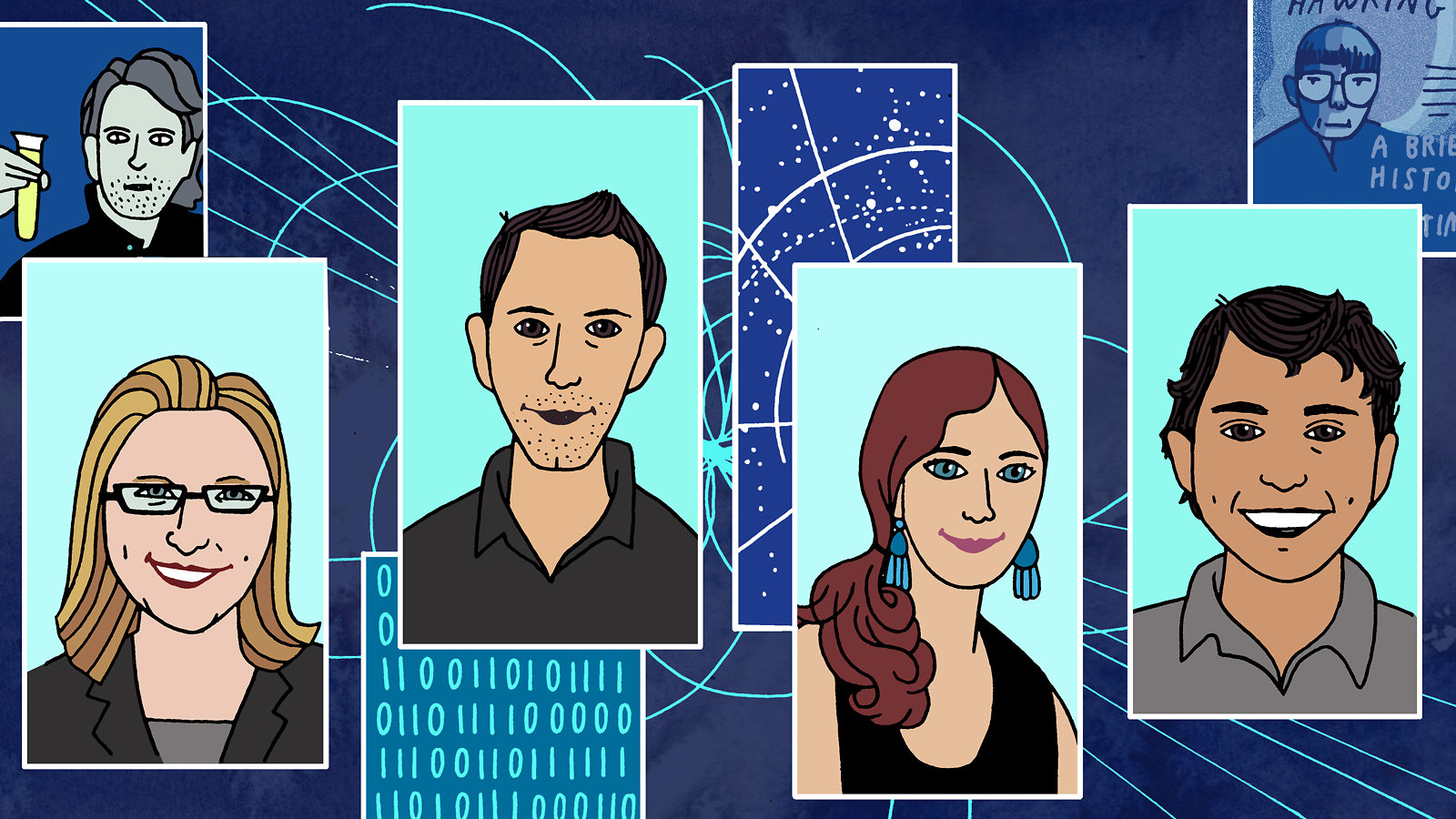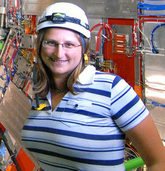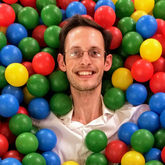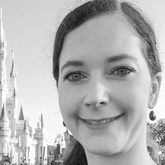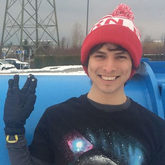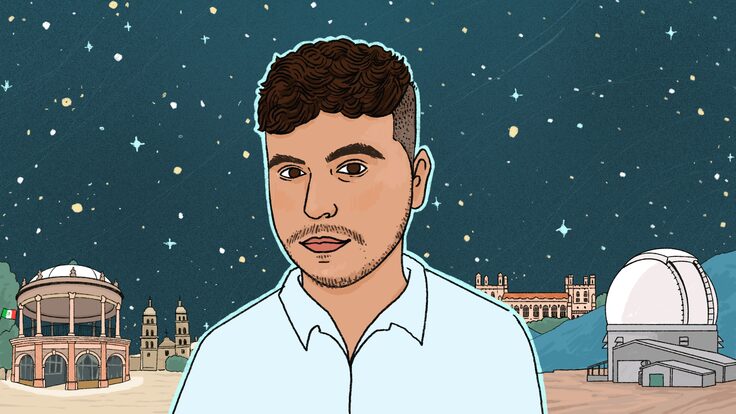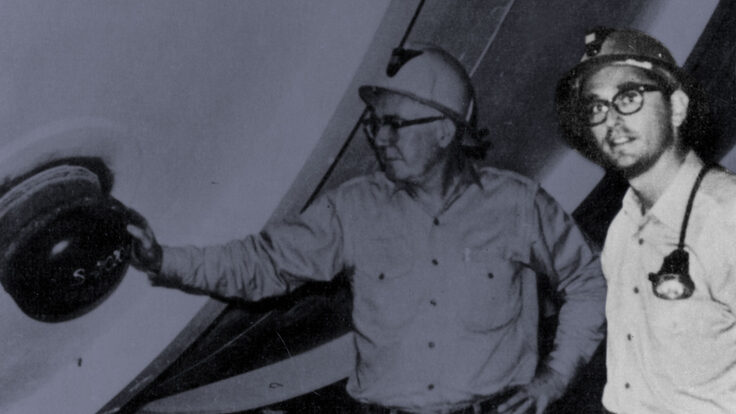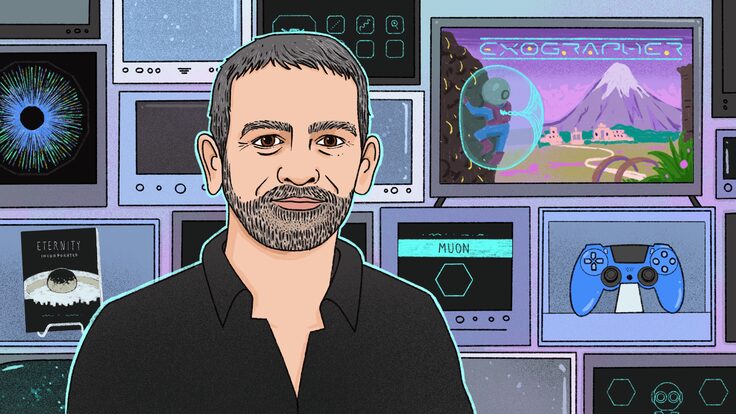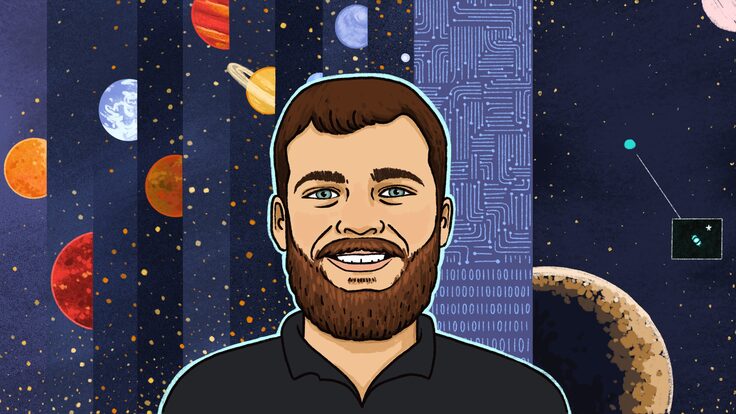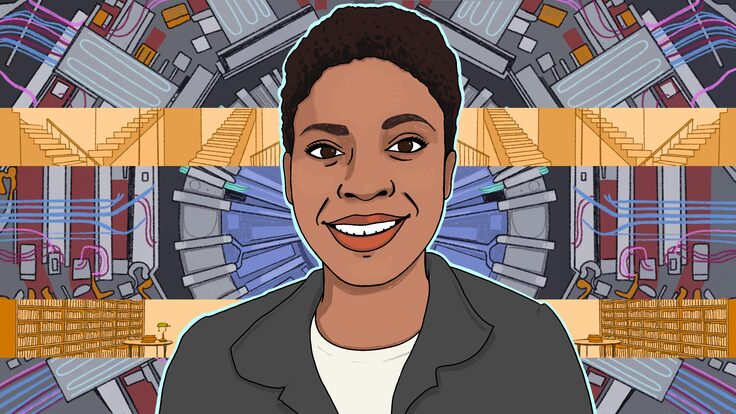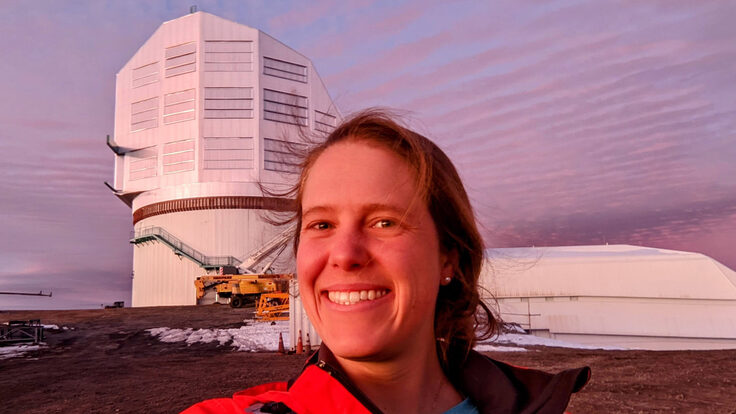The discovery of the Higgs boson, considered the missing piece of the Standard Model of particle physics, was the result of a marathon of methodical work performed by hundreds of scientists, many of them graduate students and postdocs.
Six years later, Symmetry catches up with four scientists who followed their curiosity from Higgs research to brand new enterprises.
Joanna Weng
When Joanna Weng was a kid, there was never any question about whether she would pursue science.
“I had a chemistry experimental kit as a kid, and I wanted to understand how things work,” she says. “Also, MacGyver was my favorite TV series, and he was a physicist as well.”
In college, Weng’s physics professor told stories about CERN. Her uncle, also a physics professor, told her about the streets there named after famous physicists.
“It seemed like such a magical place,” she says.
As a master’s student, she had the opportunity to see CERN for herself, and she was hooked. She stayed at the European research center, working on experiments at the Large Hadron Collider, through her PhD and then afterward as a postdoc. She was surprised by how well the gigantic collaborations worked and loved the international environment.
“Flat hierarchies and nationality don’t really matter if everyone is pursuing the same goal,” she says. “Working with these people was truly amazing. I’m still friends with many of them today.”
By the time the LHC first started on September 10, 2008, Weng was in her first year as a postdoc and had already spent five years working to commission the CMS detector and creating simulations of what new discoveries such as the long-sought Higgs boson would look like in the CMS experiment. She was ready. But less than 10 days later, she and her colleagues were hit with a major setback: A faulty electrical bus connection led to extensive damages of several LHC magnets, and the accelerator was temporarily out of commission.
“It was a frustrating time for my generation of physicists,” she says.
While engineers repaired the LHC, Weng and her colleagues continued to test and optimize their software and data transfers. (“Looking back,” she says, “I should have taken more holidays.”)
The accelerator restarted on November 20, 2009. In 2010, Weng finally got her hands on her first batch of LHC data. On July 4, 2012, the CMS and ATLAS collaborations declared the discovery of the Higgs boson.
“It was great,” Weng says, “but I was also a bit disappointed we did not discover something completely unexpected, something new. It felt like we just confirmed something everybody was expecting anyway.”
She considered her options. “I didn’t want to keep moving from postdoc to postdoc, and trying to become a professor didn’t seem like a good option either, due to the very limited number of fixed positions,” she says. “After 10 years of fundamental research, I decided to do something more applied.”
After taking some time off, Weng found a job as a risk analyst for a Swiss nuclear power plant. Her responsibilities drew heavily on her ability to simulate and evaluate data as a means of predicting the future.
“The Fukushima nuclear disaster in Japan happened in part because the strength and risks of tsunamis were underestimated,” she says. “To evaluate the safety of the nuclear power plant, we looked at everything from the likelihood of a plane crashing into the power plant to simulating and evaluating what would happen during a natural disaster, such as a flooding. It was very exciting, and I learned a lot in new areas like engineering and reliability predictions.”
After the plant was scheduled to be shut down in 2019, Weng started teaching at a university in Zürich. “They were looking for someone with experience evaluating risks and also knowledge in particle accelerators,” she says. “It was a very specific profile which matched my experience perfectly.”
Today, Weng’s career has come nearly full circle. She works on safety analysis for particle accelerators, and she collaborates with colleagues at CERN and the European Spallation Source in Sweden.
“Looking back, I made the right choice of both doing particle physics and then leaving particle physics,” she says. “I enjoyed my life at CERN, and I’m enjoying my life after.”
Andrew Hard
In 2012, Andrew Hard had just started his second year of graduate school when his adviser, University of Wisconsin Professor Sau Lan Wu, asked him to get a head start analyzing a fresh set of data collected by the ATLAS experiment at the LHC.
“I was young and eager, so I agreed,” he says.
For the next several months, Hard worked around the clock in what turned out to be the final sprint in a decades-long marathon to find the Higgs boson.
“There was no work-life balance during the discovery,” he says. “I was even questioned by the Swiss police one time as I left CERN because they didn't believe that anyone would work until 3 a.m.”
Now Hard spends his hours analyzing data for Google—and usually gets home in time for dinner with his wife. “The days are still a bit long, but it beats the late nights and Sunday meetings in graduate school,” he says.
Like most physicists, Hard was drawn to particle physics because of his fondness for problem solving. “I love a challenge,” he says. “Understanding the nature of the universe is one of the hardest problems I can imagine.”
The start-up of the LHC offered budding researchers like Hard the opportunity to tackle what had been one of the most enduring questions in physics: How do fundamental particles get their mass? According to Hard, this was both exciting and all-consuming.
He was working on a search for two photons coming from the decay of a single, massive particle—a rare (but clear and clean) predicted sign of the Higgs. On June 22, 2012, he and another colleague ran the data through their code, and a prominent bump immediately arose right around a mass range where the ATLAS scientists thought they might find it.
“We soon got confirmation that other ATLAS analysts were seeing the same thing,” Hard says.
Not long after, the ATLAS and CMS experiments announced the discovery of the Higgs.
“I actually went through a miniature existential crisis following the public announcement of the results,” Hard says. “Everything had been focused on this one thing: discovery. Once that was over, I didn't know what to do with myself.”
After earning his PhD, Hard decided to pursue a new kind of search.
“During my first interview with Google, I mentioned that CERN and Google are both in the business of search, and the primary difference is the dataset,” he says. “The interviewer seemed to like that.”
Today, Hard is a software engineer using machine learning to improve GBoard, a virtual keyboard for mobile devices with features such as and hand-drawn emoji recognition and voice dictation. He says his training as a physicist prepared him to work across domains such as computing, statistics, mathematics and electronics, and his regular research presentations made him more confident as a public speaker.
He says he’s proud of his time working at CERN and his contributions to the discovery of the Higgs.
“I think that CERN plays an invaluable role in growing the collective knowledge of our species, and I was glad to contribute to that endeavor. My personal focus has just switched to increasing access to that knowledge.”
Géraldine Conti
Géraldine Conti may have found her career path wishing on a star.
“During high school I started taking astronomy classes,” she says. Her fascination with astronomy led to a fascination with particle physics, which eventually led to her current job at the Walt Disney Company.
“When I discovered that you could do machine learning at Disney, which for me is the most magical industry, I was so excited,” she says.
Conti earned her PhD in 2010 working on the LHCb experiment at the Large Hadron Collider at CERN. The hunt for the Higgs boson was heating up, so for her postdoc she decided to switch experiments and join in on the excitement. “The LHC and its experiments were designed to look for the Higgs,” she says. “I thought that if the Higgs would be discovered at the LHC, I should definitely be part of its discovery.”
She started a postdoctoral research position at Harvard University, where she developed models that forecasted background events that mimic the signals predicted for the Higgs for the ATLAS experiment. She honed her ability to sift through the large and complicated data sets and find clandestine patterns.
In 2012, the ATLAS and CMS experiments announced the discovery of the Higgs boson. In 2016, Conti used her experience with large data sets to land a job at Disney. “I’m working with our Disney parks partners, applying the latest developments in machine learning to help them find ways to offer even better, more personalized guest experiences,” she says.
She says she finds surprisingly little difference between her current work at Disney and previous career as a physicist. “In both, we have research projects, develop code to do the analyses, and work in an international environment,” she says. “Only the nature of the data is fundamentally different.”
In addition to teaching her to draw meaning and insight from large and complex data sets, Conti found that her work as a physicist made her more dynamic and adaptable.
“As a physicist, you work on hardware, software and physics analyses, often simultaneously,” she says. “You get a broad field of competences, but most importantly, you get the confidence that you can adapt to new topics quickly and with success.”
Manuel Olmedo
Manuel Olmedo remembers looking through used books as a 15-year-old at a cafe in Tijuana on in 2004 and finding a copy of A Brief History of Time by Stephen Hawking in Spanish.
“It had nice pictures of the fission process,” he says. “I showed it to my dad, and he got it for me as a gift.”
Nine years later, he found himself in a setting straight out of Hawking’s book: working at CERN European research center, studying the recently discovered Higgs boson.
Olmedo was born in Mexico and moved with his family to the US when he was 13. His school placed him in the second lowest level of their English-as-a-second-language courses due to his reading comprehension skills.
“So I went to the library, grabbed a book that looked hard and started reading,” he says. “As I got better, I started reading Harry Potter.”
He remembers reading a science textbook around that time and seeing a short segment that stuck with him: It was about the CDF and DZero experiments at Fermi National Accelerator Laboratory, where scientists had discovered the top quark in 1995. “I didn’t really know English,” he says, “but I remember seeing this sidebar about a woman who studied quarks on the DZero experiment and thinking, ‘What’s a quark?’”
By the 9th grade, Olmedo had transitioned out of the ESL program. After high school, he went to the University of California, Santa Barbara to study physics.
“I had this amazing professor,” Olmedo says. “I would go to his office hours and we would ponder the world together. He taught me that understanding reality meant looking beyond what our eyes could see.”
In spring 2013, Olmedo moved to CERN to analyze a rare decay of the Higgs boson—into a pair of particles of light—as a part of the CMS experiment.
“The CMS data sets were too big to do this analysis efficiently,” he says. “My main project was to identify and isolate the pertinent information so that the entire collaboration could move much faster.”
Olmedo’s work helped finalize the so-called CMS Higgs legacy paper, which showed the collaboration’s first detailed measurements of the particle it had co-discovered.
After completing his PhD, Olmedo wanted to see what else particle physics had to offer. “I felt like particle physics is this huge tree, and I was just hanging onto a little twig. There’s so many branches and so many ways to look for new physics.”
Oldmedo is still looking beyond what his eyes can see, studying invisible particles called neutrinos as a postdoc for the University of Hawaii and a member of the Antarctic Impulse Transient Antenna collaboration. The ANITA experiment floats huge balloons carrying radio antennas above Antarctica to look for signs of high-energy cosmic neutrinos skimming the ice and emitting radio waves.
“It’s a much smaller experiment and collaboration than CMS, but I find myself using a lot of the same skills,” Olmedo says. “It’s also a lot of fun, which I think is a very important quality in scientific research.”



